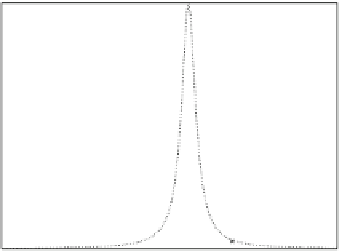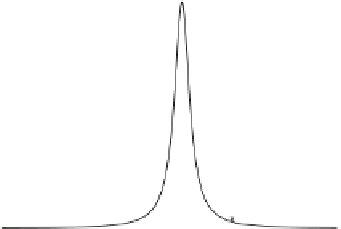Chemistry Reference
In-Depth Information
a
b
Mott Insulator
Original Metallic band
p
p
Doublon
k
k
Fig. 8.21 (a) Electron-lattice interaction in the one-body problem of the doublon in the Mott
insulator. (b) Same interaction in the original metallic band
(0.2, 0.072)
(S1, S2)=(0, 0)
+
-
w=11.05 0.27 meV
w=10.06 meV
(0.3, 0.3)
+
-
w=13.41 0.82 meV
(0.8, 0.2)
+
-
w=16.59 1.5 meV
1.2
1.3
1.4
1.5
1.6
Energy (eV)
Fig. 8.22 Calculated spectra for the
dp
model. The curve of
corresponds to
the NiBr case. Reprinted from Iwano [
39
]. Copyright (2006) by the American Physical Society
ðS
1
; S
2
Þ¼ð
0
:
2
;
0
:
072
Þ
where
d
k
and
q
p
are the Fourier component of the doublon and the lattice, respec-
tively. What is important is the functional form of the coupling function
gðpÞ
. In the
Holstein model, it is constant leading to the efficient formation of the polaron. On
the other hand, the function in
H
d
-
l
has a functional form of
gðpÞ/
2
S
sin
ðp=
2
Þ
.This
means the suppression of the polaron formation that uses the components of
p
~0,
as illustrated in Fig.
8.21a
. By the way, the polaron in the CDW insulator is formed
mainly by the components around
p ¼ p
. This is directly related to the fact that the
wave vector of the CDW is
, which is the nesting vector of the original metallic
band as shown in Fig.
8.21b
. The polaron formation then occurs efficiently using
this functional form. In contrast, the e-l interaction that a doublon or a holon feels is
suppressed nontrivially, and this also holds for a doublon-hole pair. Calculations
based on the full hamiltonian that incorporates the e-l interaction also support this
idea. For example, a vanishing Raman Stokes shift [
36
] and a very small peak line
broadening as small as 2 meV for realistic parameter values [
39
] are found in those
calculations. The very sharp peak observed in the optical conductivity spectrum is
thus concluded to be a manifestation of this effect. In Fig.
8.22
, we show the spectra
p











































































































































Search WWH ::

Custom Search